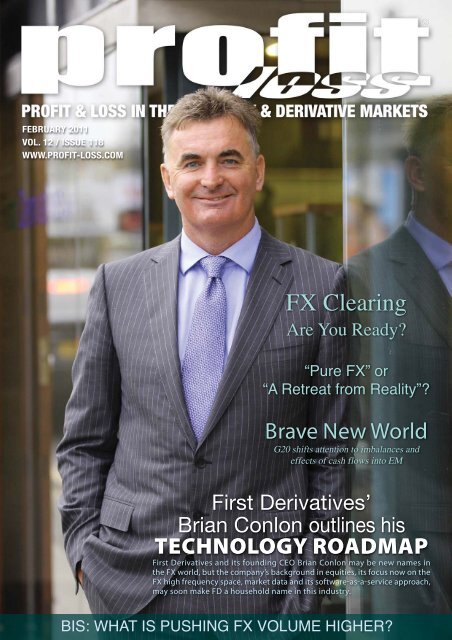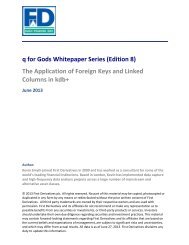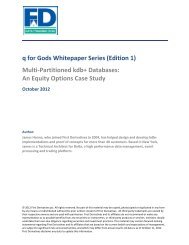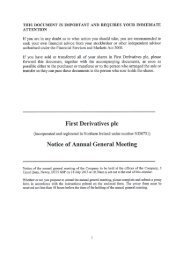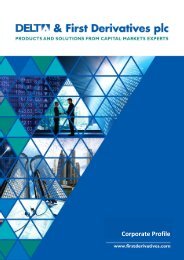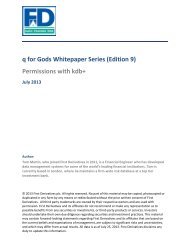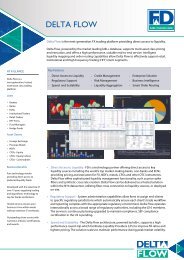Brian Conlon Outlines His Technology Roadmap - First Derivatives plc
Brian Conlon Outlines His Technology Roadmap - First Derivatives plc
Brian Conlon Outlines His Technology Roadmap - First Derivatives plc
You also want an ePaper? Increase the reach of your titles
YUMPU automatically turns print PDFs into web optimized ePapers that Google loves.
®<br />
FEBRUARY 2011<br />
VOL. 12 / ISSUE 118<br />
WWW.PROFIT-LOSS.COM<br />
FX Clearing<br />
Are You Ready<br />
“Pure FX” or<br />
“A Retreat from Reality”<br />
Brave New World<br />
G20 shifts attention to imbalances and<br />
effects of cash flows into EM<br />
<strong>First</strong> <strong>Derivatives</strong>’<br />
<strong>Brian</strong> <strong>Conlon</strong> outlines his<br />
TECHNOLOGY ROADMAP<br />
<strong>First</strong> <strong>Derivatives</strong> and its founding CEO <strong>Brian</strong> <strong>Conlon</strong> may be new names in<br />
the FX world, but the company’s background in equities, its focus now on the<br />
FX high frequency space, market data and its software-as-a-service approach,<br />
may soon make FD a household name in this industry.<br />
BIS: WHAT IS PUSHING FX VOLUME HIGHER
ISSN: 1467-2650 © 2011 P&L SERVICES LTD. ALL RIGHTS RESERVED<br />
This article first appeared in: Profit & Loss Magazine,<br />
February 2011 | issue 118 | Volume 12<br />
visit our website: www.profit-loss.com<br />
<strong>First</strong> <strong>Derivatives</strong>’ <strong>Brian</strong> <strong>Conlon</strong> <strong>Outlines</strong> <strong>His</strong><br />
TECHNOLOGY ROADMAP<br />
<strong>First</strong> <strong>Derivatives</strong> and its founding CEO <strong>Brian</strong> <strong>Conlon</strong> may be new names in the FX world, but the<br />
companyʼs background in equities, its focus now on the FX high frequency space, market data<br />
and its software-as-a-service approach, may soon make FD a household name in this industry.<br />
Julie Ros: It has been nearly a year since FD’s acquisition of<br />
Cognotec; can you give me an update on how the integration<br />
has gone<br />
<strong>Brian</strong> <strong>Conlon</strong>: In the period since we acquired them, we’ve<br />
been building our product suite with a common technology<br />
base and bringing the two organisations closer together. At<br />
this juncture, we are effectively operating as one<br />
organisation. Branding-wise, <strong>First</strong> <strong>Derivatives</strong> is the brand<br />
and the product is Delta, so the legacy Cognotec products are<br />
now Delta RealStream and Delta Margin. In terms of our<br />
aspirations to slot their technology and customer base into<br />
our overall group-wide structure, it has been a great success.<br />
At the start, we had more of an equity and institutional focus,<br />
but with Cognotec we got deep expertise in the FX space, as<br />
well as access to the retail and buy side. So from that<br />
perspective we feel the acquisition and integration have gone<br />
very well.<br />
JR: A year ago, you indicated that FD would be making a<br />
significant investment in the Cognotec products. Have there<br />
been any new products launched or that are in development<br />
BC: The story has really been about integration. The<br />
RealStream product was pretty much in its infancy when we<br />
took over. We consolidated the product, and now have 10<br />
customers actively using it. We’ve been building up the<br />
feature set in terms of the venues we can trade on, as well as<br />
enhancing the algo program trading features and enhanced<br />
hedging and risk management features. On the margin side,<br />
we’re adding a mobile front end, as well as expert advisor<br />
and graphing capabilities. So we’ve continued to build out<br />
the feature set and couple the product more closely with our<br />
algo trading offering, which is aimed primarily at the high<br />
frequency community.<br />
JR: How has deployment of the RealStream technology<br />
(which offers a range of integration and STP tools aimed at<br />
the HF space) been received<br />
BC: After the acquisition of Cognotec, the fact that we were<br />
able to retain the customers gives us comfort on two fronts.<br />
Customers were sufficiently supportive of the technology<br />
and gave us the breathing space to move forward with the<br />
technology. Also, they were very supportive because we<br />
could offer a bigger organisation that had a broader base in<br />
terms of the markets we work in and the customers we work<br />
with. The technology has been very well received, and the<br />
fact that we now have the ability to operate in the ultra-high<br />
frequency world is also something that our customers are<br />
very excited about. It helps them as well on the brokerage<br />
side in terms of the types of people they are able to deal<br />
with, so for some that had only been dealing on the retail<br />
side on the brokers, they’re now attracting high frequency<br />
clients into their operations because we can give them a high<br />
frequency offering on the trading side. This means we have<br />
been able to help our customers grow their own customer<br />
base because of the offering that we have. In short, we think<br />
the technology has been very well received in terms of what<br />
we’ve done with it – for example, moving from Chicago to<br />
NY4 has been a big boost in terms of reducing latency,<br />
reliability and performance.<br />
JR: How has FD integrated Cognotec’s products into its<br />
overall offering<br />
BC: We’ve rebranded Cognotec’s products and where there’s<br />
overlap, we’re migrating and integrating the functionality, so<br />
within a very short space of time it’s going to be effectively<br />
the same product suite, and in essence, it already is.<br />
JR: Have you seen increased interest in FX from new and<br />
existing clients<br />
BC: That’s part of the macroeconomic trend. The FX market<br />
is growing so rapidly, while equity has not been growing at<br />
the same pace as it was a few years ago. The FX market is<br />
fragmenting and there has been lot of volatility, so there’s<br />
renewed interest in the FX market from a trading<br />
perspective. We’ve seen a lot of interest from clients on the<br />
FX side, because high frequency and program trading is<br />
relatively new to FX compared to the equity market where<br />
it’s been around a number of years. So between the<br />
macroeconomic trend in terms of the volatility in the FX<br />
market, the increase in retail FX trading, the move towards<br />
more equity type trading environments and fragmentation of<br />
liquidity as more high frequency traders become price<br />
I<br />
February 2011 I Profit & Loss I www.profit-loss.com
COVER<br />
FEATURE<br />
<br />
“WE’VE SEEN A LOT OF INTEREST<br />
FROM CLIENTS ON THE FX SIDE,<br />
BECAUSE HIGH FREQUENCY<br />
AND PROGRAM TRADING IS<br />
RELATIVELY NEW TO FX<br />
COMPARED TO THE EQUITY<br />
MARKET WHERE IT’S BEEN<br />
AROUND A NUMBER OF YEARS.“<br />
www.profit-loss.com I Profit & Loss I February 2011<br />
II
FEATURE<br />
COVER<br />
“Everyone needs data – volumes are growing and<br />
now weʼve got the software to deal with the data and<br />
the expertise to advise people on how to better<br />
organise, store, access and analyse it.”<br />
makers instead of just price takers, has meant that we’ve<br />
definitely seen an increase in interest in the FX side of<br />
things. So in short, yes!<br />
JR: FD has a track record of acquiring niche capital markets<br />
technology companies. Can you expand on this philosophy<br />
by providing some insight into the other acquisitions the firm<br />
has made in the past two years<br />
BC: It’s safe to say that if you looked at this company three<br />
years ago, we were a capital markets service provider<br />
primarily focussed on the UK and to a certain extent, North<br />
America. We made a strategic decision around three years<br />
ago to have a product offering as well as a services<br />
offering. We could go one of two ways – grow organically,<br />
building our own software, or acquire companies. We have<br />
a hybrid model. We acquired Hologram in Australia, for<br />
example, which gave us a presence in a market where we<br />
didn’t have one before, so that improved our global reach in<br />
terms of our ability to service markets in North America,<br />
Europe and Asia Pacific. So Hologram was like a<br />
geographical acquisition. In terms of our other acquisitions,<br />
we have been very strong in market data, so we acquired<br />
Reference Data Factory, which has a reference data offering<br />
that sits side by side in our data arena. We also acquired a<br />
niche data consulting firm about six months ago, LakeFront<br />
Data Ventures, to increase our expertise and presence in the<br />
data market.<br />
So now we have a very strong presence in the data market,<br />
we have a very strong market data offering, a very strong<br />
reference data offering, and a very strong data consulting<br />
operation. Everyone needs data – volumes are growing and<br />
now we’ve got the software to deal with the data and the<br />
expertise to advise people on how to better organise, store,<br />
access and analyse it.<br />
The other main acquisition was on the Cognotec side. Now<br />
we have a better focus and expertise on the FX side and can<br />
provide our software as a service because of Cognotec’s<br />
expertise in hosting. We didn’t have that before, so now all<br />
our software is available as a hosted service. <strong>His</strong>torically, the<br />
markets we’ve been offering have essentially been on the<br />
investment banking side; now we have a market on the retail,<br />
brokerage and buy sides. So it’s a combination in terms of<br />
our strategy, to determine small niche companies that can<br />
accelerate our overall strategic goals. Along the way, we also<br />
picked up an increased interest in Kx Systems, which has a<br />
high-performance and time series analysis database, Kdb+.<br />
JR: What about risk management<br />
BC: When we acquired Hologram, we were in the process<br />
of building two products – a risk management product and<br />
a product for exchanges. The acquisition allowed us to<br />
accelerate on the risk management side and on the<br />
exchanges side, we signed up the Singapore Exchange<br />
about nine months ago for our market monitoring<br />
software. Our exchange software and risk management<br />
have all been developed on the same technology platform;<br />
they all talk to each other, as well as the Delta Algo, Delta<br />
Stream and Delta Margin products, meaning we have a<br />
very broad offering and consulting arm to support all those<br />
different fronts.<br />
JR: What types of customers do you have<br />
BC: We have a number of products under the Delta umbrella<br />
that have different customer sets. Delta Algo, for example, is<br />
used by banks and buy side for algorithmic program trading;<br />
Delta Stream is a market data product which is used for data<br />
capture, real time P&L, and real time risk. Delta RDF –<br />
Reference Data Factory – is used by hedge funds and buy<br />
side.<br />
JR: Generally speaking, how has the high frequency community<br />
fared over the past 18 months Have you seen particular<br />
regions or segments outperform<br />
BC: By its nature it’s a very dynamic, secretive,<br />
unregulated industry, so it’s hard to get any real data to<br />
parse or analyse, but on the equity side I’d say it’s been a<br />
bit more difficult because the market’s maturing – the arms<br />
race in terms of driving latency down can only go so far.<br />
Whatever arbitrage opportunities that are there are being<br />
driven out – the flash crash episode didn’t help either in<br />
terms of its focus from the regulatory side, and there has<br />
also been stability in terms of volatility. Whereas with other<br />
asset classes like FX and commodities, those markets aren’t<br />
as mature, especially on the commodity side where it’s a lot<br />
more fragmented in terms of the types of products you can<br />
trade – there’s a lot of room left in those to apply the<br />
technology foundation that the equity guys have. They will<br />
continue to grow and the heavy duty regulation of banks is<br />
going to drive people into smaller organisations<br />
themselves, where they set up their own high frequency<br />
operations. So I think it’s probably mixed equity, FX and<br />
other asset classes that are starting to get some traction and<br />
really make some money.<br />
JR: Do you see banks spinning off high frequency/prop<br />
desks or perhaps outsourcing this function to HF firms<br />
BC: It’s going to be very difficult for a bank that has a<br />
profitable desk to shut it down, but history shows that when<br />
regulations are put in place, the very clever people at banks<br />
find ways and means of dealing with that without breaking<br />
the rules. It’s going to add to the complexity of everything –<br />
particularly when regulations are not common across all<br />
jurisdictions. Layer on top of that the retail side – you’ve got<br />
the NFA coming in with its own regulations, Japan trying to<br />
protect the retail space, new capital adequacy directives<br />
coming out – it’s very much an uncertain, very confused<br />
landscape, which makes it hard to make any predictions, but<br />
I think there will be more fragmentation and more high<br />
frequency firms setting up. I do think that regulation will<br />
mean more fragmentation in terms of smaller operations and<br />
III<br />
February 2011 I Profit & Loss I www.profit-loss.com
COVER<br />
FEATURE<br />
<br />
trading desks being spun off and even banks investing in<br />
outside operations.<br />
JR: You recently announced a partnership with Trading Cros<br />
Connects (TXC). Can you tell me about the significance of<br />
that alliance<br />
BC: Our partnership with TXC is designed to provide a onestop<br />
shop for people setting up new high frequency trading<br />
desks. The fact that we were chosen by TXC ahead of a<br />
number of our competitors is a validation of our offering.<br />
Delta Algo is cross asset classes – it works for equities, fixed<br />
income, commodities and FX, so the fact that TXC picked us<br />
over the others is a big story for us.<br />
JR: What attracted you to TXC<br />
BC: We’re a software and consulting operation, so in<br />
terms of giving us a one-stop shop offering to newly<br />
fledged high frequency trading desks or a HF hedge fund<br />
or operation, we can now go to them with a single<br />
offering. TXC will provide the hosting, collocation,<br />
hardware setup and market data connectivity. For our part,<br />
we have the flexibility, time to market and feature rich<br />
niche software, which will effectively allow a small<br />
operation to hit the ground running very quickly. They<br />
don’t have to worry about broker relationships and in<br />
many cases, TXC will be helping out on the capital side.<br />
So for a small operation (especially for people who’ve left<br />
a large firm) this allows them to hit the ground running<br />
very fast and only have to deal with one organisation.<br />
That was very attractive to us. TXC have facilities in all<br />
the major trading centres – London, Tokyo, US – they<br />
cover a vast swathe of FX and fixed income markets. For<br />
us it was essentially a partnership that made sense from an<br />
infrastructure side, a marketing side, the offering side, as<br />
well as investors – and the due diligence they undertake<br />
when they bring people onto the TXC platform helps us as<br />
well. So there are a number of benefits for us and we’re<br />
excited about the relationship.<br />
JR: Is this FD’s first entry into a productised software offering<br />
BC: We’ve been working with the largest investment banks<br />
around the world implementing mission critical software<br />
since 1996. One of the software offerings we work with is<br />
Kdb+. We have a 22% interest in that organisation, and have<br />
been working with them for nigh on 10 years. During that<br />
time, we’ve gained a lot of experience building complex<br />
enterprise systems. What we have done in the last two to<br />
three years is take that IP and turn it into our own product.<br />
So we’ve had our own product out there for several years,<br />
primarily in the market data capture and program trading<br />
space. Cognotec was of interest to us for its FX focus and<br />
expertise, their customers and the ability to quickly enter the<br />
retail and buy side space. So we had two flagship offerings<br />
historically that have been Delta Algo and Delta Stream,<br />
which is our market data capture application. So I guess<br />
we’ve been a software company for two to three years, as<br />
well as our traditional consulting operation.<br />
“Itʼs an uncertain, very confused regulatory landscape,<br />
but I think you will see more fragmentation<br />
in FX and more high frequency firms setting up”<br />
JR: How does FD’s software offering differ from its competitors<br />
BC: One of the differences is that as we build out our<br />
offerings, they all have a common technology base. So,<br />
as opposed to a firm like Sungard that has a portfolio of<br />
products that all have different underlying technologies –<br />
all our products are seamless. They talk to each other and<br />
they can work individually and collectively. Within<br />
themselves, they all address slightly different markets,<br />
but the underlying technology base is all the same. So<br />
that’s one key differentiator. Another is that our offerings<br />
very much have a common target in terms of data. Data is<br />
our speciality and we’re dealing with organisations that<br />
are dealing with very high volumes of data, very high<br />
throughput and the need to process that very quickly.<br />
Low latency is one of our differentiators. Couple that<br />
with productivity and we can get our offering to market<br />
very quickly. So we have a rich offering which is very,<br />
very fast, competing with massive volumes of data –<br />
nobody can deal with the volumes of data that we can and<br />
that’s because we use Kdb+ as our underlying<br />
technology, which is proven and effectively the market<br />
leader in dealing. Because our technology is built on<br />
Kdb+, we naturally inherit the unique advantages that<br />
Kdb+ brings to the table.<br />
JR: What other plans exist in terms of enhancing the existing<br />
offering<br />
BC: On the margin side, we have a number of significant<br />
offerings, as well as plans in the offing. We are embracing<br />
the latest technology in terms of mobile trading and trading<br />
through apps, expert advisor and better graphical interaction.<br />
We are also improving our offering in terms of latency<br />
monitoring applications and back testing. We are going to be<br />
partnering with some pretty significant data providers to<br />
provide historical data for people to back test their models<br />
against.<br />
JR: What are the keys to continued growth<br />
BC: I see continued growth as a function of the<br />
fragmentation of the market, increasing focus on FX<br />
aggregation in that there are more sources of liquidity than<br />
there have been before, which makes smart order routing and<br />
CEP aspects more complex. From our perspective, that’s<br />
where the growth is going to come from. There’s going to be<br />
more discreet operations trading in the market, more sources<br />
of liquidity and the regulation is going to force people to<br />
produce more reports, more granular analysis of data and<br />
reporting of data in terms of transaction cost analysis. From<br />
our perspective, the increased amount of data, drive for lower<br />
latency, fragmentation of liquidity and drive for more<br />
operations, should give us a bigger market to sell our<br />
products and services to.<br />
www.profit-loss.com I Profit & Loss I February 2011<br />
IV
FEATURE<br />
COVER<br />
JR: You mentioned commodities earlier, is this a focus for<br />
FD<br />
BC: There’s definitely demand, especially on the retail side.<br />
So there will be more offerings on the retail side, precious<br />
and base metals, energy, softs and ags as well. One of the<br />
prime drivers in our technology roadmap is to allow us to<br />
seamlessly deal with those asset classes, even cross asset<br />
trading is becoming more prevalent. There are opportunities<br />
in certain countries with currency restrictions, where we can<br />
combine retail FX trading with underlying commodity<br />
trading; so expanding in the FX arena is something we’re<br />
very cognisant of and which our technology roadmap is<br />
going to allow us to open up to our customers.<br />
JR: What other key areas do you see for growth<br />
BC: Data, driving lower latency, moving into more asset<br />
classes, increased requirements for reporting and transaction<br />
and risk management, as well as FX aggregation because of<br />
the different numbers of price makers and venues that are<br />
emerging. ■<br />
<strong>Brian</strong> <strong>Conlon</strong> is chief executive officer<br />
and founder of <strong>First</strong> <strong>Derivatives</strong>. He has<br />
worked in the capital markets sector<br />
since 1990. Having trained with KPMG<br />
before joining the risk management<br />
team in Morgan Stanley International,<br />
London, he then joined Sungard as a<br />
capital markets consultant. During his<br />
time with Sungard, <strong>Conlon</strong> worked with more than 60 financial<br />
institutions worldwide. He left in 1996 to set up FD.<br />
FD is headquartered in Northern Ireland and has additional<br />
offices in New York and London. FD’s services include<br />
consulting, support, technology and third party products. The<br />
company offers a range of software products in its Delta Suite,<br />
including algorithmic/program trading, market data services,<br />
risk management applications and market data management<br />
software.<br />
In addition to organic growth, FD has acquired several high tech<br />
specialty companies in recent years. In October 2009 it bought<br />
New York-based reference data management company,<br />
Reference Data Factory (RDF). The firm also has taken a 22%<br />
interest in Kx Systems, a California-based firm that sells a highperformance<br />
and time series analysis database, Kdb+. At the end<br />
of March 2009, the firm acquired Australia-based Lepton<br />
Solutions (trading as Hologram), which is now trading as <strong>First</strong><br />
<strong>Derivatives</strong> Pty Ltd. The firm acquired Cognotec in mid-<br />
February 2010, and six months ago, acquired LakeFront Data<br />
Ventures, a boutique data management company.<br />
V<br />
February 2011 I Profit & Loss I www.profit-loss.com


